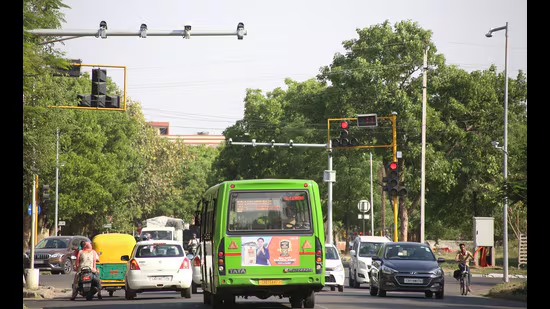Chandigarh, Aug 11: Chandigarh is set to bring all 109 of its traffic intersections under the watch of high-resolution CCTV cameras, expanding its Intelligent Traffic Management System (ITMS) citywide to track violations and issue automated challans. Officials say the move will make the city one of the few in India with 100 percent ITMS coverage.
The system, currently installed at 40 junctions under the Smart Cities Mission, uses automatic number plate recognition and violation detection technology. According to police, the expansion is aimed at creating uniform enforcement across the city, reducing accidents and deterring offenses such as speeding, red-light jumping and dangerous driving.
“Expanding ITMS citywide will not only boost traffic regulation efficiency but also help reduce road accidents by creating a consistent deterrent against violations,” a senior police official said. “Once implemented, Chandigarh could become one of the few cities in India with complete ITMS coverage.”
The UT engineering department has been tasked with initiating steps for the full rollout after detailed discussions in recent meetings. Authorities say the ITMS feeds real-time data to traffic control rooms, enabling swift action against offenders and assisting in crime detection, congestion management and emergency response coordination.
The system’s impact is already visible. In 2024, ITMS recorded 8.46 lakh automated challans, a steep jump from 78,000 in 2020. At the same time, driving licence suspensions have fallen sharply — from 4,057 in 2021 to just 302 last year.
SSP (Traffic) Sumer Pratap Singh credited the decline to the constant surveillance of ITMS cameras. “Automated monitoring has kept violations in check by capturing evidence of offences like signal jumping, speeding and helmetless riding,” Singh said.
Registering and Licensing Authority (RLA) data shows riding without a helmet was the leading cause of licence suspension in 2024, with 196 cases, followed by drunk driving (55), speeding (20) and mobile phone use while driving (9). In 2023, those numbers were significantly higher, with 457 suspensions for helmetless riding, 74 for drunk driving, 107 for speeding and 18 for phone use.
The downward trend contrasts with earlier years. In 2022, there were 1,139 suspensions, and in 2021, 4,057 — more than eight times the 2024 figure.
Under Section 19 of the Motor Vehicles Act, 1988, and Rule 21 of the Central Motor Vehicle Rules, 1989, licences can be suspended for up to six months for offences including drunk driving, speeding, red-light jumping and phone use while driving. Riding without a helmet results in a three-month suspension and a fine.

